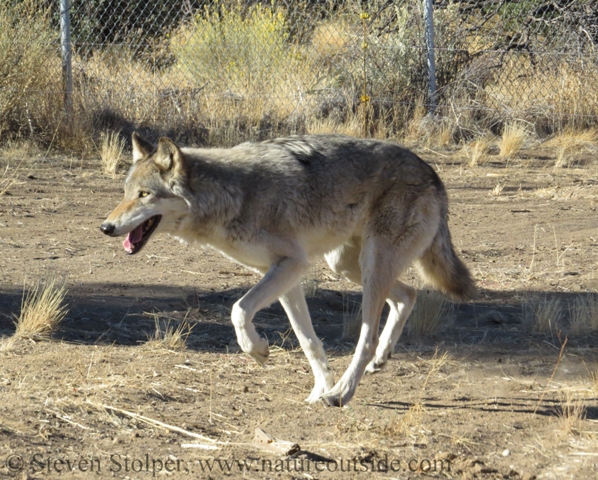
The Gray Wolf (Canis Lupus)
Human professors aren’t always the best. Sometimes it takes an animal teacher.
For many years I have wanted to learn how to track wolves. I’ve hiked and backpacked in Montana and Wyoming. But I never saw a sign of these elusive creatures.
An episode from Ray Mears’ television series, Survival, further fueled my desire to learn more about them. Ray tracks and films a wolf pack in Idaho just ten days before the state removes them from its endangered species list (allowing wolves to be hunted). The footage of wolf behavior ignited my interest in these enigmatic animals. In particular, I wanted to learn how to track them.
Easier Said than Done
 At one time wolves roamed throughout North America. But today resident populations exist only in 9 states: Alaska, Idaho, Oregon, Michigan, Minnesota, Montana, Washington, Wisconsin and Wyoming.
At one time wolves roamed throughout North America. But today resident populations exist only in 9 states: Alaska, Idaho, Oregon, Michigan, Minnesota, Montana, Washington, Wisconsin and Wyoming.
The resident wolf population in California was extirpated sometime in the 1800’s1. Since I live in California, I must travel to another state to track and observe wolves. This is an expensive proposition. And you may not see a wolf when you arrive at your destination. Wildlife observation comes with no guarantees. The time, money, and travel invested in a trip might amount to naught.
Another problem with traveling to see wolves is that you may only learn half the story. While it is valuable to see tracks, observing the animal in motion can provide years’ worth of insight. And witnessing the animal expressing its natural behaviors is priceless. You cannot count on having those experiences during a brief, budget-constrained, trip out of state.
A Novel Idea

This is the novel idea behind Jim Lowery’s wolf tracking class. Jim Lowery is the author of the Tracker’s Field Guide. He and Mary Brooks run the Earthskills school in Southern California.
The class uses captive wolves to give students the chance to:
- Observe the animals in motion and relate it to the resulting tracks
- See different gaits to help students look at tracks and visualize movement
- Witness the animals’ behaviors and temperament to gain insight into the “essence” of the creature

But can a dog teach old people new tricks? Emphatically YES! I took a similar course from Jim and Mary many years ago to learn to track mountain lions. Observing a live mountain lion in the class greatly improved my ability to track them in the wild. The wolf tracking course expands on that approach.

But where do you rent a pack of wolves? The answer is Hollywood. The class was held at a facility in Southern California that supplies many of the animal actors seen on television and in movies. The facility and the attention the trainers give to the animals creates a safe and enjoyable environment to conduct the class.
The Teacher’s Credentials (Canis Lupus)
Lets talk for a moment about the Gray Wolf, also known as the Timber Wolf.
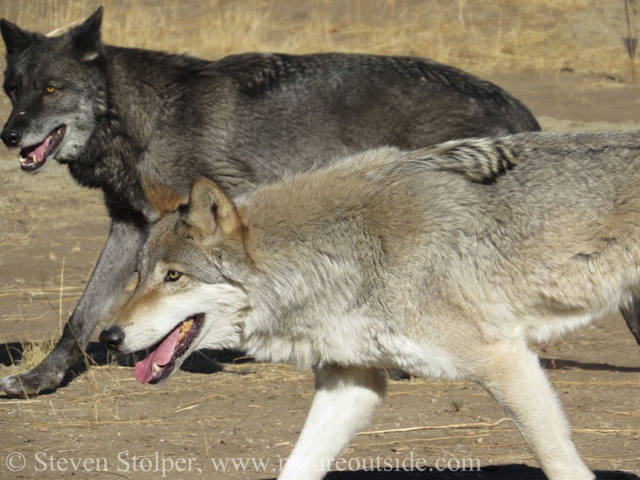
Both of these animals are Gray Wolves
Appearance
The Gray Wolf (aka Timber Wolf) is not necessarily gray. They may be white, black, tawny gray, or a combination of those colors. Experts estimate that about half the population is actually gray.
Longevity
On average wolves live seven years in the wild. But captive wolves have lived to be as old as twelve years.
Size and Weight
Gray wolves can weigh between 40 and 175 pounds. But typical adults range between 90 and 110 pounds. Female wolves weigh slightly less than males. Wolves can exceed 5-1/2 feet ( 1.7 m) from the tip of the nose to the end of the tail. Again, females tend to be slightly smaller than males.
Habitat
Wolves are habitat generalists and once ranged throughout North America. They are resilient and adaptable, which allows them to survive wherever there is sufficient food. A typical wolf territory varies between 30-60 square miles (78-153 km2)2. However in northern environments, where prey is sparse, they can expand to more than 1,000 square miles (2,590 km2).
Wolves are Built to Run
Wolves spend a great deal of their time traversing their territories. A wolf pack travels through the night but is most active around dusk and dawn. Wolves can spend up to 50% of their lives traveling!2
They trot around 5-6 mph (8-10 kph) and can cover an incredible 45 miles (72 km) in a single night2. In the pursuit of prey, wolves can sprint up to 38 mph (64 kph)! And they can maintain these high speeds for up to 20 minutes!

Food
Wolves eat large ungulates like elk, deer, moose, or caribou. They will also snack on beaver, rabbits, voles, and other small animals. They may also scavenge opportunistically.
Wolves can exert a jaw pressure of up to 1,500 pounds per square inch! This is twice as much as a German Shepherd and five times more than a human!
Reproduction
Wolves breed once a year between late January and March. Pups are born helpless, deaf, and blind. But they are fully mature by 10 months of age.
Wolves are social and travel in packs that vary in size from just 2 individuals to as many as 36. The most common pack size is 6-8 wolves. The packs consist of the male/female pair that breed (alphas) and their older offspring. All adults in the pack help to raise the pups.
Female wolves begin to breed when they are 2 years old. Young males disperse to establish new territories. They usually disperse about 50 miles (80 km). Females disperse as well, but usually shorter distances than the males. However, wolves have been known to disperse as much as 500 miles.
Tracks and Sign
Wolves are much larger than coyotes, an animal they might be mistaken for at a distance. Here is a picture that shows the difference in size and appearance between coyotes and wolves:
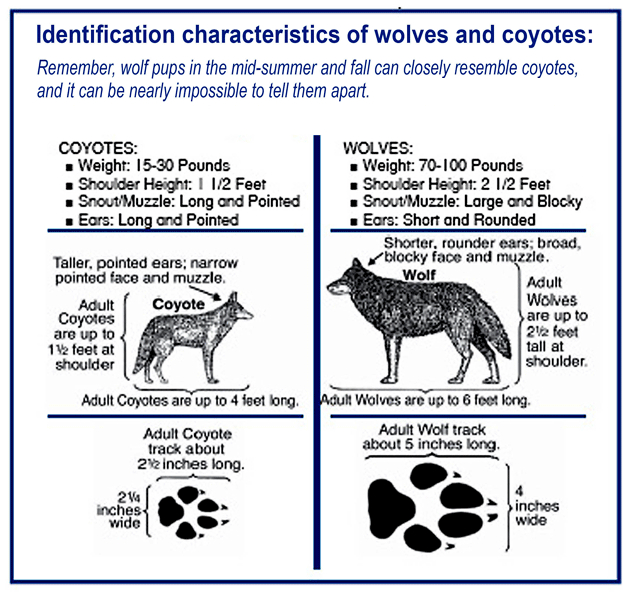
The Oregon Department of Fish and Wildlife created this picture. So measurements shown are for the population residing in that state. I modified this diagram by removing verbiage.
Many people mistake the tracks of other animals for wolf tracks. Dog, coyote, and mountain lion tracks are often misinterpreted as wolf. An average-sized wolf makes a track between 3 ½ to 4 ½ inches long (without claws) and 3 to 4 ½ inches wide. Here is a downloadable Tip Sheet (PDF) created by the Oregon Department of Fish and Wildlife. It helps explain the differences between wolf tracks and tracks left by other animals. It shows a picture of wolf and coyote tracks side-by-side.
Wolves use scent to communicate. So, like coyote, may leave scat in prominent places along trails. They may sometimes scrape the ground after urinating or defecating to help broadcast scent from glands between their toes. Wolf scat diameter ranges from 0.5 to 1.5 inches, but is usually greater than an inch. It can vary in appearance, so it is usually its large size that is most diagnostic.
Importance
Studies of areas where wolves have been reintroduced reveal a startling fact: Wolves can change the very appearance of the land. By controlling deer and elk populations, they prevent overgrazing of riparian habitats. This, in turn, benefits many other plant and animal species. It turns out that wolves play a key role in keeping many ecosystems healthy.
What to do if you are confronted by a wolf
Bears, cougars, and wolves tend to avoid people and animal attacks are extremely rare4. They are more likely to occur when wolves are habituated to people, when dogs are involved, or if wolves are sick.
If you encounter an aggressive wolf, act the same way you would with an aggressive mountain lion. Here are some tips for dealing with an aggressive mountain lion. If I was confronted by a pack of wolves, I would consider doing something I have not seen the experts recommend: I would climb a tree.
The Day Arrives
The early morning brought with it a piercing blue sky. The gibbous moon had not yet completed its graveyard shift and a steady wind fetched across the arid basin. Gusts occasionally caught dry grass, lifting it skyward.
We trudged across the enclosure and observed the preparations underway. The enclosure appeared to be the size of a football field. It was surrounded by stiff chain link fence sporting barbed wire across the top. The gate was locked behind us, and we were as much occupants of the pen as the animals we came to study.
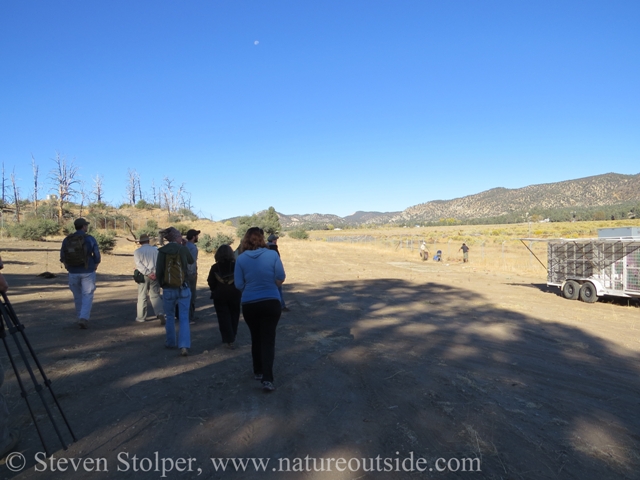
The class walks across the enclosure, roughly the size of a football field
Inside the enclosure is an L-shaped area surrounded by a “hot wire” fence. One portion of the “L” was about 50 yards long by 30 wide. It joined a smaller area about 20 yards square. One portion of the electrified fence swung open and closed for access to the interior.
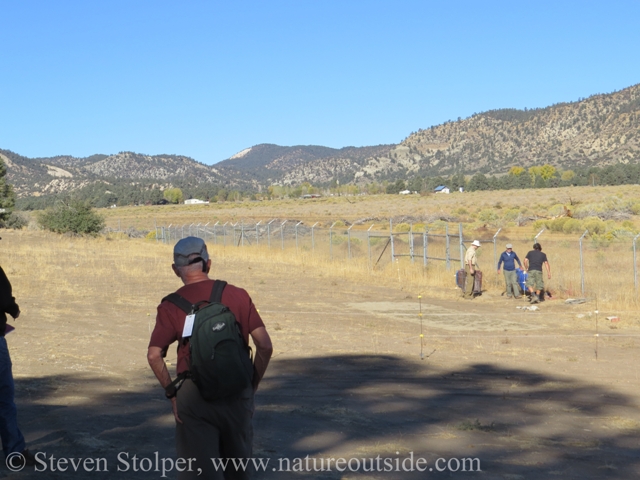
A better view of the hot wire and our sand trap
Outside the hot wire was the large trailer that housed the wolves. The trailer was designed for African lions and provided spacious accommodations for the two wolves observing us from its interior.
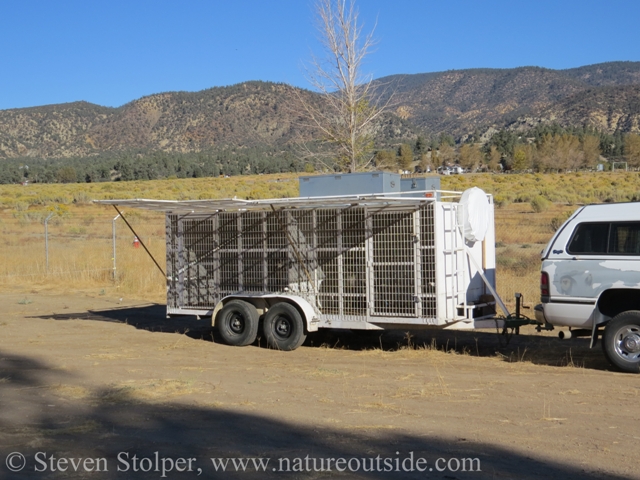
The trailer provides shade and roomy accommodations for the wolves. The two wolves have separate areas.
The class was carefully choreographed to ensure our safety and that the animals were happy and relaxed. It would have a natural rhythm. The trainers would open the trailer and lead the two wolves on leashes into the area enclosed by the hot wire fence. Once the fence was closed behind them, the trainers would “unleash the hounds.”
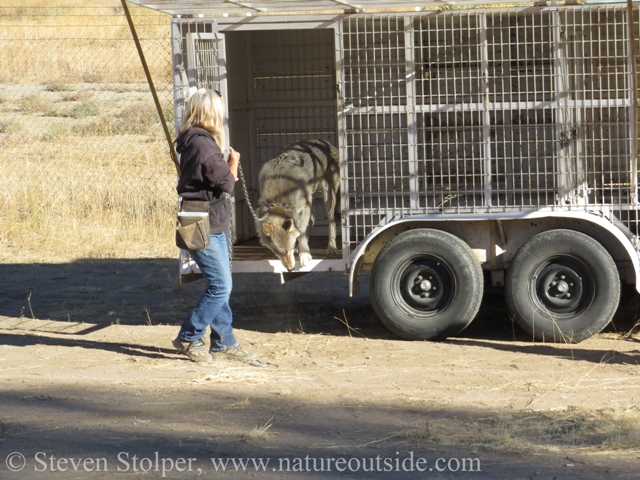
Harley makes his appearance
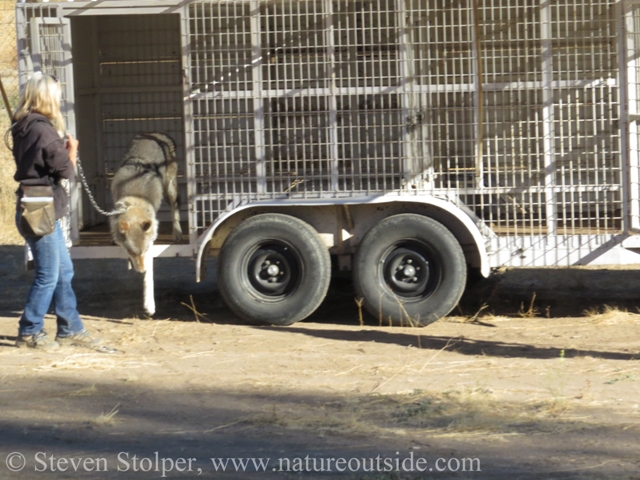
The wolves were calm and relaxed from the beginning (more so than some of the students)
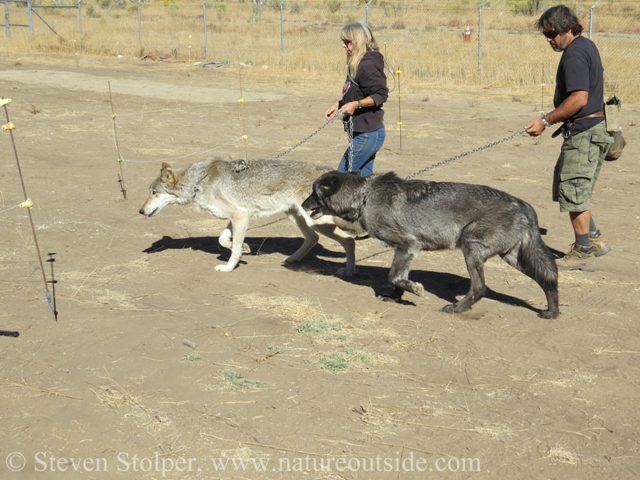
The wolves were eager and excited to enter the area we prepared
The wolves are conditioned to stay away from the electrified fence. Each has its own comfort distance from it. However, the fence was not actually electrified for the class. But Sssshhhhh, don’t tell the wolves! 🙂
The wolves performed a series of maneuvers that the class had asked. But mostly, they romped around as we observed and photographed. It was joy to watch them having so much fun.
At various intervals, the wolves were escorted back to the trailer while the students entered to observe the tracks left behind. We analyzed the tracks and gaits and compared how their motion matched the signs on the ground. After raking the ground to prepare it for a new set of tracks, the process would repeat.
Words cannot capture the novelty and awe of being so close to these amazing creatures. But I will try to do my best in part 2.
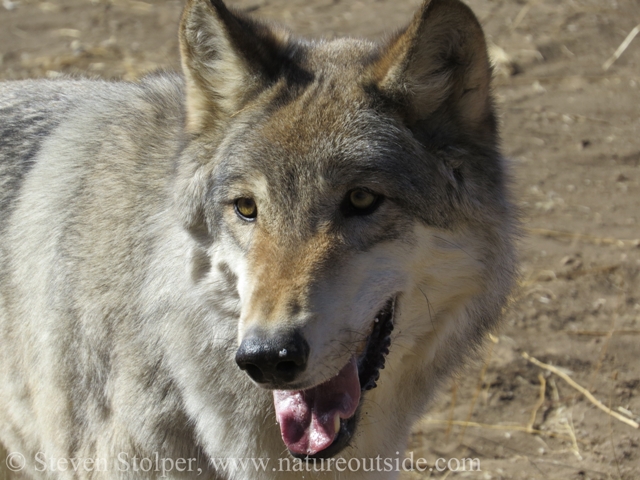
Professor Harley
References
1. The Former Distribution of Gray Wolves in California, Ronald M. Jurek, California Department of Fish and Wildlife, 1994.
2. Behavior of North American Mammals, Mark Elbroch and Kurt Rinehart
3. Tracker’s Field Guide: A Comprehensive Manual For Animal Tracking, James C. Lowery
4. Oregon Department of Fish and Game Website (Wolves)
More Wolves on NatureOutside
Wolves Teach a Master Class (Part 2)
Wolves Teach a Master Class (Part 3)
If you enjoyed this article you may want to read others in the Tracking Section.



Leave a Comment